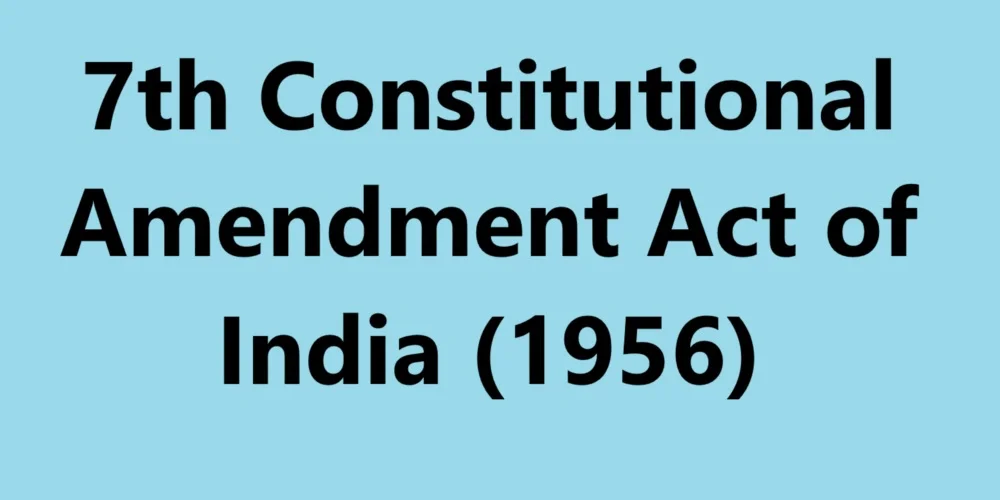The 7th Constitutional Amendment Act of India (1956)
The Seventh Constitutional Amendment Act of 1956 is a significant Amendment in reshaping state borders. This topic speaks on “Seventh Amendment (1956)” which is an important area for preparing UPSC and other competitive government job examinations.
The Background of the Seventh Amendment
- Linguistic Diversity: India has a lot of languages: This was not properly dealt with by how the British made states or states were made after independence.
- Different language groups wanted their own states: Groups that spoke different languages started asking for states of their own based on the language. Important language movements included:
- Andhra Movement (Telugu speakers): The demand for a separate state of Andhra.
- Demand for a Kannada state: The demand for a state for Kannada speakers.
- Gujarat Movement (Gujarati-speaking people): The request for a separate state just for Gujarati speakers.
- Demand for a Marathi-speaking state: The request for a separate state for Marathi speakers.
- SRC Recommendations: The SRC’s report, submitted in 1955, formed the basis for the Seventh Amendment. The committee suggested organizing states based on language, culture, and easy administration. The SRC’s suggestions led to making many new states and union territories.
Key Points of Seventh Amendment:
- Main Purpose: Reorganize the boundaries of states in India.
- Articles Amended: 1, 3, 49, 80, 81, 82, 131, 153, 158, 168, 170, 171, 216, 217, 220, 222, 224, 230, 231 and 232.
- New Articles included: Inserted Articles through 7th ammendment are 258A, 290A, 298, 350A, 350B, 371, 372A and 378A.
- The States Reorganization Commission (SRC) was set up to recommend the reorganization of states.
- Amended Part Sechudles: Part 8 and schedules 1, 2, 4, and 7 were amended through this.
- Redrawing State Boundries: Following suggestions from the SRC, many new states and union areas were made. Therefore the borders of current states were changed.
- Article 231 was amended: It allowed retired judges from high courts to keep practicing law in other high courts or the supreme court. A high court could now also handle legal cases over multiple states or Union Territories.
- 14 states and six union territories were created, and Class A, Class B, Class C, and Class D states were abolished.
- It was suggested to create Union Territories.
Read More: Age Limit for Various Constitutional Posts In India
Impact of the Seventh Amendment
Linguistic Reorganization of States:
- The most important change from the Seventh Amendment was how it created states based on language.
- It led to states being formed where most people spoke the same language.
- For instance, Andhra Pradesh was made for Telugu speakers, Karnataka for Kannada speakers, and Kerala for Malayalam speakers.
Promotion of Regional Identity:
- The Seventh Amendment played an important part in encouraging identity and cultural ties to different regions.
- It permitted linguistic and cultural groups to maintain and develop their unique identities.
- Valuing linguistic variety helped strengthen regional cultures and languages.
Administrative Efficiency:
- By Reorganizing states according to the languages spoken, the Seventh Amendment aimed to make governing easier.
- It was believed that states where most people spoke the same language and shared similar cultures would be simpler to manage.
- They were expected to run more smoothly and efficiently since residents could better understand each other.
Redrawing of Boundaries:
- Several state lines were modified following this change to the constitution.
- Forming new states this way wasn’t problem-free or without disagreement, but it resulted in places where people shared a stronger sense of being part of the same location.
Allocation of Seats: in COUNCIL OF STATES:
- The changes to state borders had effects on how seats were given out in the Rajya Sabha (Council of States).
- Since boundaries between states were modified, the Fourth Schedule was updated.
- This schedule says how many seats each state and union territory gets in the Rajya Sabha.
| States | Allocated Seats |
|---|---|
| Andhra Pradesh | 18 |
| Assam | 7 |
| Bihar | 22 |
| Bombay | 27 |
| Kerala | 9 |
| Madhya Pradesh | 16 |
| Madras | 17 |
| Mysore | 12 |
| Jammu and Kashmir | 4 |
| Orissa | 10 |
| Punjab | 11 |
| Rajasthan | 10 |
| Uttar Pradesh | 34 |
| West Bengal | 16 |
| Delhi | 3 |
| Himachal Pradesh | 2 |
| Manipur | 1 |
| Tripura | 1 |
| Total | 220 |
Historical and Political Significance:
- The Seventh Amendment addressed a long-standing public demand and played an important part in how politics worked in India.
- It dealt with reorganizing how language was used. This change helped determine the nation’s political future.
Read More: Important Amendments of Indian Constitution
Summary
To summarize, the Seventh Amendment of 1956 was a crucial moment in India’s timeline. Because it acknowledged and addressed the linguistic and cultural diversity of the nation. The linguistic and cultural bonds between people led to the evolution of states. This structure helps provide leadership that preserves local characteristics and senses of identity.
FAQs from from 7th Amendment
RAW details on the 7th Amendment can be found here.
